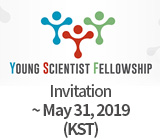주메뉴
- About IBS 연구원소개
-
Research Centers
연구단소개
- Research Outcomes
- Mathematics
- Physics
- Center for Underground Physics
- Center for Theoretical Physics of the Universe (Particle Theory and Cosmology Group)
- Center for Theoretical Physics of the Universe (Cosmology, Gravity and Astroparticle Physics Group)
- Dark Matter Axion Group
- Center for Artificial Low Dimensional Electronic Systems
- Center for Theoretical Physics of Complex Systems
- Center for Quantum Nanoscience
- Center for Exotic Nuclear Studies
- Center for Van der Waals Quantum Solids
- Center for Relativistic Laser Science
- Chemistry
- Life Sciences
- Earth Science
- Interdisciplinary
- Center for Neuroscience Imaging Research (Neuro Technology Group)
- Center for Neuroscience Imaging Research (Cognitive and Computational Neuroscience Group)
- Center for Algorithmic and Robotized Synthesis
- Center for Genome Engineering
- Center for Nanomedicine
- Center for Biomolecular and Cellular Structure
- Center for 2D Quantum Heterostructures
- Institutes
- Korea Virus Research Institute
- News Center 뉴스 센터
- Career 인재초빙
- Living in Korea IBS School-UST
- IBS School 윤리경영


주메뉴
- About IBS
-
Research Centers
- Research Outcomes
- Mathematics
- Physics
- Center for Underground Physics
- Center for Theoretical Physics of the Universe (Particle Theory and Cosmology Group)
- Center for Theoretical Physics of the Universe (Cosmology, Gravity and Astroparticle Physics Group)
- Dark Matter Axion Group
- Center for Artificial Low Dimensional Electronic Systems
- Center for Theoretical Physics of Complex Systems
- Center for Quantum Nanoscience
- Center for Exotic Nuclear Studies
- Center for Van der Waals Quantum Solids
- Center for Relativistic Laser Science
- Chemistry
- Life Sciences
- Earth Science
- Interdisciplinary
- Center for Neuroscience Imaging Research (Neuro Technology Group)
- Center for Neuroscience Imaging Research (Cognitive and Computational Neuroscience Group)
- Center for Algorithmic and Robotized Synthesis
- Center for Genome Engineering
- Center for Nanomedicine
- Center for Biomolecular and Cellular Structure
- Center for 2D Quantum Heterostructures
- Institutes
- Korea Virus Research Institute
- News Center
- Career
- Living in Korea
- IBS School
News Center
IBS Researchers Reveal New Light-Matter Interaction in Time-Modulated Photonic MediaA research team including scientists at the Institute for Basic Science (IBS) in South Korea has uncovered a groundbreaking way for atoms to emit and absorb light using time-periodic photonic structures, known as photonic time crystals (PTCs). Their findings challenge the conventional understanding of light-matter interaction and reveal a new physical process called spontaneous emission excitation, where atoms absorb energy from temporal modulation while emitting light. This phenomenon is impossible in static environments. For decades, scientists have controlled spontaneous emission by engineering the spatial environment around atoms, such as using resonant cavities or photonic crystals. However, no prior work had shown how time-varying optical environments affect the fundamental nature of spontaneous emission. The team applied Floquet analysis and classical light-matter theory to photonic time crystals (PTCs), materials whose optical properties vary periodically in time rather than space. They discovered:
Notably, the study overturns earlier predictions that spontaneous emission should vanish at the time-crystal band edge. Instead, the team showed that the non-orthogonality of Floquet modes, quantified by the Petermann factor, counteracts this effect to yield a finite and even enhanced emission rate. “Our work demonstrates that time modulation provides a previously unexplored lever for controlling light-matter interaction,” the authors explain. “Unlike traditional photonic crystals, photonic time crystals provide an intrinsically nonequilibrium environment where gain, loss, and mode non-orthogonality give rise to entirely new physical processes This discovery could open new directions in quantum optics, time-varying photonic devices, and energy-efficient light sources. Future research will explore the full quantum electrodynamic description of time-modulated photonic platforms.
Notes for editors
- References
- Media Contact
- About the Institute for Basic Science (IBS) |
| Next | |
|---|---|
| before |
- Content Manager
- Public Relations Team : Yim Ji Yeob 042-878-8173
- Last Update 2023-11-28 14:20










![[그림]](https://www.ibs.re.kr/dext5data/2025/11/20251117_173345280_78452.jpg)

